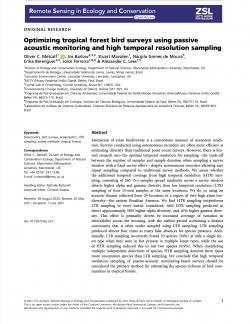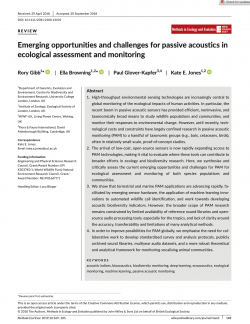Optimizing tropical forest bird surveys using passive acoustic monitoring and high temporal resolution sampling

Type
Journal
Authors
Category
Article
[ Browse Items ]
Publication Year
2021
Publisher
Remote Sensing in Ecology and Conservation, United States
URL
[ private ]
Abstract
Estimation of avian biodiversity is a cornerstone measure of ecosystem condi- tion. Surveys conducted using autonomous recorders are often more efficient at estimating diversity than traditional point-count surveys. However, there is lim- ited research into the optimal temporal resolution for sampling—the trade-off between the number of samples and sample duration when sampling a survey window with a fixed survey effort—despite autonomous recorders allowing easy repeat sampling compared to traditional survey methods. We assess whether the additional temporal coverage from high temporal resolution (HTR) sam- pling, consisting of 240 15-s samples spread randomly across a survey window detects higher alpha and gamma diversity than low temporal resolution (LTR) sampling of four 15-min samples at the same locations. We do so using an acoustic dataset collected from 29 locations in a region of very high avian bio- diversity—the eastern Brazilian Amazon. We find HTR sampling outperforms LTR sampling in every metric considered, with HTR sampling predicted to detect approximately 50% higher alpha diversity, and 10% higher gamma diver- sity. This effect is primarily driven by increased coverage of variation in detectability across the morning, with the earliest period containing a distinct community that is often under sampled using LTR sampling. LTR sampling produced almost four times as many false absences for species presence. Addi- tionally, LTR sampling incorrectly found 70 species (34%) at only a single for- est type when they were in fact present in multiple forest types, while the use of HTR sampling reduced this to just two species (0.9%). When considering multiple independent detections of species, HTR sampling detected three times more uncommon species than LTR sampling. We conclude that high temporal resolution sampling of passive-acoustic monitoring-based surveys should be considered the primary method for estimating the species richness of bird com- munities in tropical forests.
Description
https://doi.org/10.1002/rse2.227
Number of Copies
1
| Library | Accession No | Call No | Copy No | Edition | Location | Availability |
|---|---|---|---|---|---|---|
| Main | 268 | 1 | Yes |


